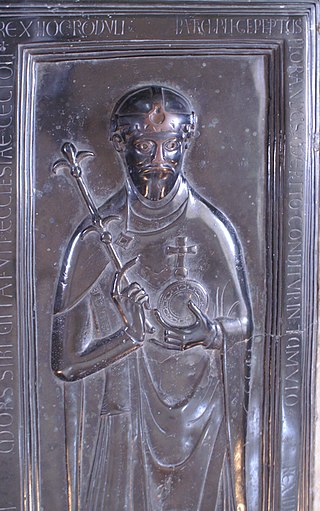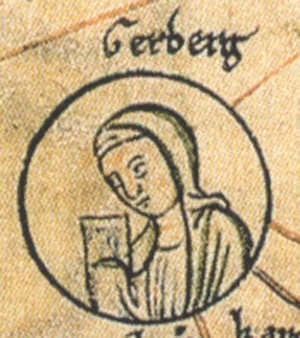
Richard III was the duke of Normandy who reigned from August 1026 to his death. His brief reign opened with a revolt by his brother.

Rudolf of Rheinfelden was Duke of Swabia from 1057 to 1079. Initially a follower of his brother-in-law, the Salian emperor Henry IV, his election as German anti-king in 1077 marked the outbreak of the Great Saxon Revolt and the first phase of open conflict in the Investiture Controversy between Emperor and Papacy. After a series of armed conflicts, Rudolf succumbed to his injuries after his forces defeated Henry's in the Battle on the Elster.

Welf I was Duke of Bavaria from 1070 to 1077 and from 1096 to his death. He was the first member of the Welf branch of the House of Este. In the genealogy of the Elder House of Welf, he is counted as Welf IV.
Conrad I was Duke of Swabia from 983 until 997. His appointment as duke marked the return of Conradine rule over Swabia for the first time since 948.

Gerberga of Saxony was a Queen of France by marriage to Louis IV of France between 939 and 954. She ruled as regent of France during the minority of her son Lothair in 954–959.

Welf III, the last male member of the Swabian line of the Elder House of Welf, was Duke of Carinthia and Margrave of Verona from 1047 until his death.

Welf II was a Swabian count and a member of the Elder House of Welf.
Gulkhan-Eudokia was the first Empress consort of Manuel III of Trebizond. Her original name was Gulkhan Khatun; Eudokia was her Christian baptismal name.
Ermengarde of Anjou was the Countess of Rennes, Regent of Brittany (992–994) and also Countess of Angoulême.
Gerberga of Burgundy was a member of the Elder House of Welf. She was married firstly to Herman I, count of Werl and secondly to Herman II, Duke of Swabia.

Kunigunde of Altdorf was a member of the Swabian line of the Elder House of Welf. She was also the ancestress of the younger House of Guelph, a cadet branch of the House of Este.
Otto I, Count of Scheyern was the earliest known ancestor of the House of Wittelsbach whose relation with the House can be properly verified.
Europäische Stammtafeln - German for European Family Trees - is a series of twenty-nine books which contain sets of genealogical tables of the most influential families of Medieval European history. It is a standard reference work for those researching medieval, imperial, royal and noble families of Europe.
Richlind of Altdorf was a German noblewoman and a member of the Swabian line of the Elder House of Welf.
Ethelinde of Northeim was the daughter of Otto of Northeim and the wife of Welf I, Duke of Bavaria, and Herman of Calvelage.

Ermentrude de Roucy (Irmtrude) was a Countess and Duchess of Burgundy.
Rudolf I, Margrave of the Nordmark and Count of Stade, son of Lothair Udo II, Margrave of the Nordmark, and Oda of Werl, daughter of Herman III, Count of Werl, and Richenza of Swabia. Rudolf was the brother of his predecessors Henry I the Long and Lothair Udo III.
Ernest II, Count of Mansfeld-Vorderort was a German nobleman from the Mansfeld-Vorderort line of the House of Mansfeld. He was the fifth child and third son of Albert III (V), Count of Mansfeld, Lord in Mansfeld and Lord in Heldrungen and succeeded him on his death.
Hathui was a member of the Saxon House of Billung, who was the first abbess of Gernrode (r.959-1014).
Gerberga, Otto-William's mother, was, by her successive marriages, queen of Italy, margravine of Ivrea (965–970), and duchess of Burgundy (971/5–986/91).








